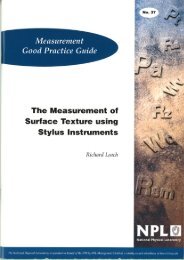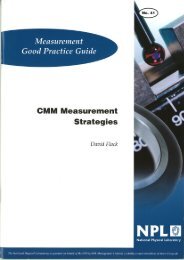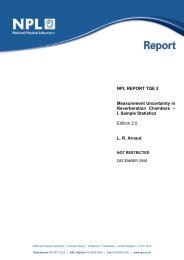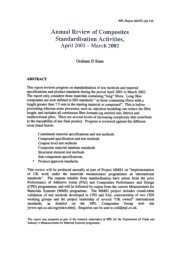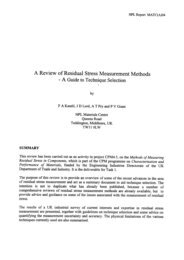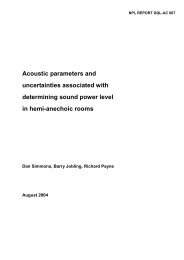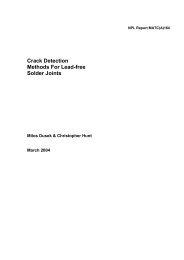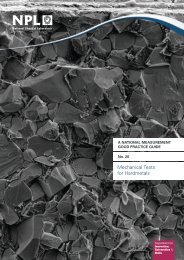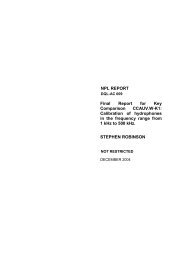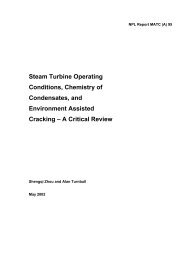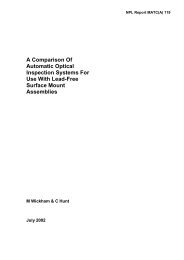Protocol for Establishing and Maintaining the Calibration - NPL ...
Protocol for Establishing and Maintaining the Calibration - NPL ...
Protocol for Establishing and Maintaining the Calibration - NPL ...
Create successful ePaper yourself
Turn your PDF publications into a flip-book with our unique Google optimized e-Paper software.
6 Good Practice Guide 93 Chapter 1<br />
1.3.1 High Voltage<br />
If it is possible to display <strong>the</strong> high voltage, its value should be recorded to note any drift<br />
(particularly downwards) or to compare with <strong>the</strong> manufacturers tolerances. If <strong>the</strong> display is not<br />
available, measurement of <strong>the</strong> check source may indicate if a problem exists. With low activities, a<br />
small change in voltage will have little effect on <strong>the</strong> measurement. However, <strong>the</strong> same change in<br />
voltage can have a large effect on <strong>the</strong> measurement of high activities. This is because<br />
recombination effects in <strong>the</strong> ion chamber change with voltage <strong>and</strong> are important at high currents.<br />
1.3.2 Display<br />
If <strong>the</strong>re is a segmented display, <strong>the</strong>re should be a facility to check that all segments are operating<br />
correctly.<br />
1.3.3 Zero Adjust<br />
This facility should be checked in accordance with <strong>the</strong> instructions in <strong>the</strong> user manual. It is useful<br />
to record <strong>the</strong> “zero” reading be<strong>for</strong>e any adjustment is made in order to identify any ongoing trend<br />
which suggests that <strong>the</strong> instrument needs repair.<br />
1.3.4 Background<br />
A sufficiently large measurement period, toge<strong>the</strong>r with an appropriate number of significant figures<br />
on <strong>the</strong> display, should be used <strong>for</strong> <strong>the</strong> background measurement. The magnitude of <strong>the</strong> background<br />
should be noted daily <strong>and</strong> compared against previous values (ideally a control chart should be<br />
maintained) or against a control value. Acceptable variations need to be determined by a series of<br />
repeated benchmark measurements at <strong>the</strong> installation stage. Background measurements should be<br />
made with <strong>the</strong> source holder in <strong>the</strong> chamber.<br />
If <strong>the</strong> measured background is higher than expected this may be due to contamination of <strong>the</strong><br />
chamber/ source holder/ liner or because of <strong>the</strong> presence of large sources nearby.<br />
1.3.5 Check Source (Relative Response)<br />
It is important that a long-lived radioactive check source is available <strong>and</strong> measured on a regular<br />
basis. These sources should be chosen <strong>for</strong> <strong>the</strong>ir long half-lives <strong>and</strong> <strong>the</strong> absence of any significant<br />
radioactive impurity. Typical sources used are 137 Cs (half-life = 30 years), 57 Co (half-life = 270<br />
days) or 226 Ra (half-life = 1600 years). However, sources such as 57 Co, which do contain<br />
impurities, have altered effective half-lives <strong>and</strong> so must be treated with caution. The check source<br />
initially checks <strong>the</strong> response of <strong>the</strong> overall system (chamber + electrometer) against a benchmark<br />
value, which is established when <strong>the</strong> system is first installed. A record should be kept of <strong>the</strong> daily<br />
checks <strong>and</strong> any adjustments documented. Daily measurements of <strong>the</strong> responses to a check source<br />
need only be per<strong>for</strong>med <strong>for</strong> instrument nuclide settings corresponding to <strong>the</strong> radionuclides, which<br />
will be measured on that day.<br />
This check gives a measure of <strong>the</strong> reproducibility [4] <strong>for</strong> day to day measurements of <strong>the</strong> ionisation<br />
chamber <strong>and</strong> electrometer combination. If checks indicate that <strong>the</strong> response suffers large r<strong>and</strong>om<br />
variations, this may suggest an inherent instability in <strong>the</strong> electrometer. If <strong>the</strong>re is an ongoing trend,<br />
which indicates that <strong>the</strong> response is continually rising (or falling), this could indicate ei<strong>the</strong>r a leak in<br />
<strong>the</strong> pressurised ionisation chamber or a progressive drift of <strong>the</strong> electrometer. In ei<strong>the</strong>r of <strong>the</strong>se<br />
cases an initial compensation could be achieved by adjusting <strong>the</strong> electrometer, but if <strong>the</strong> cumulative<br />
change is greater than 5% it should be repaired: <strong>the</strong> problem may be more than just that arising<br />
from <strong>the</strong> inherent instability of <strong>the</strong> electrometer.<br />
The check source should be a solid source, which is less prone to loss of activity than a solution. It<br />
is important to recognise that <strong>the</strong> check source is NOT a calibration source <strong>for</strong> that radionuclide. It<br />
would generally have different characteristics to those of sources, which are routinely assayed <strong>and</strong>,



